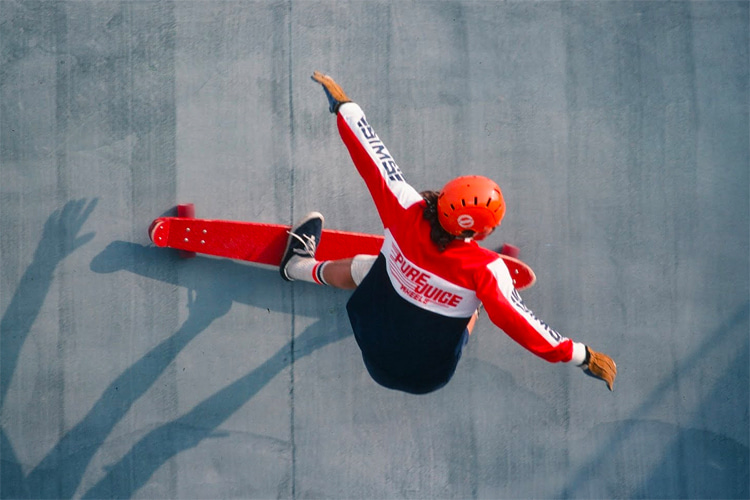Skateboarding evolved dramatically in its first 50 years. Discover the most influential male and female skateboards in the history of the sport.
Since it became an alternative to flat ocean days, sidewalk surfing grew fast, initially in California and then in the rest of the world.
Skateboarding quickly became a social, cultural, sports, and even artistic outdoor activity with a groundbreaking impact on our villages, towns, and cities.
In a couple of decades after its birth, skaters were already re-inventing the ways of riding the four-wheel board, horizontally and vertically.
By the time we reached the 1990s, skateboarding had become a multidisciplinary sport with plenty of room and roads to explore.
Freestyle, longboard, vert, and street - you can now ride anything, everywhere. Today, you can even cruise and dance on top of a skateboard.
However, the evolution of skateboarding, especially from 1950 to 2000, results from millions of hours of practice, innovation, injuries, and success from talented, above-average riders.
Let's look at some of the skateboarders who helped push the sport forward with relevant contributions to its richness.
The following list of over 100 notable skaters has been sorted alphabetically.
Andy Macdonald
Andy Macdonald was a superb 1990s vert rider.
"Skateboarding to me means freedom and expression. There's no one there telling you that there are rules. It means self-motivation and creativity, and it's the funnest thing that I know to do."
Bill Weiss
Bill Weiss comes from Toronto and is known for his completely outrageous moves on and off a skateboard.
"Skateboarding takes care of pleasure, anger, everything. It keeps my head straight."
Billy Ruff
Billy Ruff was a late 1970s and 1980s vert master. Billy was sponsored by G&S.
Bob Biniak
Bob Biniak started skating with the original Zephyr team around 1974. He went on to ride for Logan Earth Ski.
Besides riding vert, Bob was also an accomplished downhill skater and, in 1976, achieved the fastest time in the standup division at Signal Hill.
Bob Burnquist
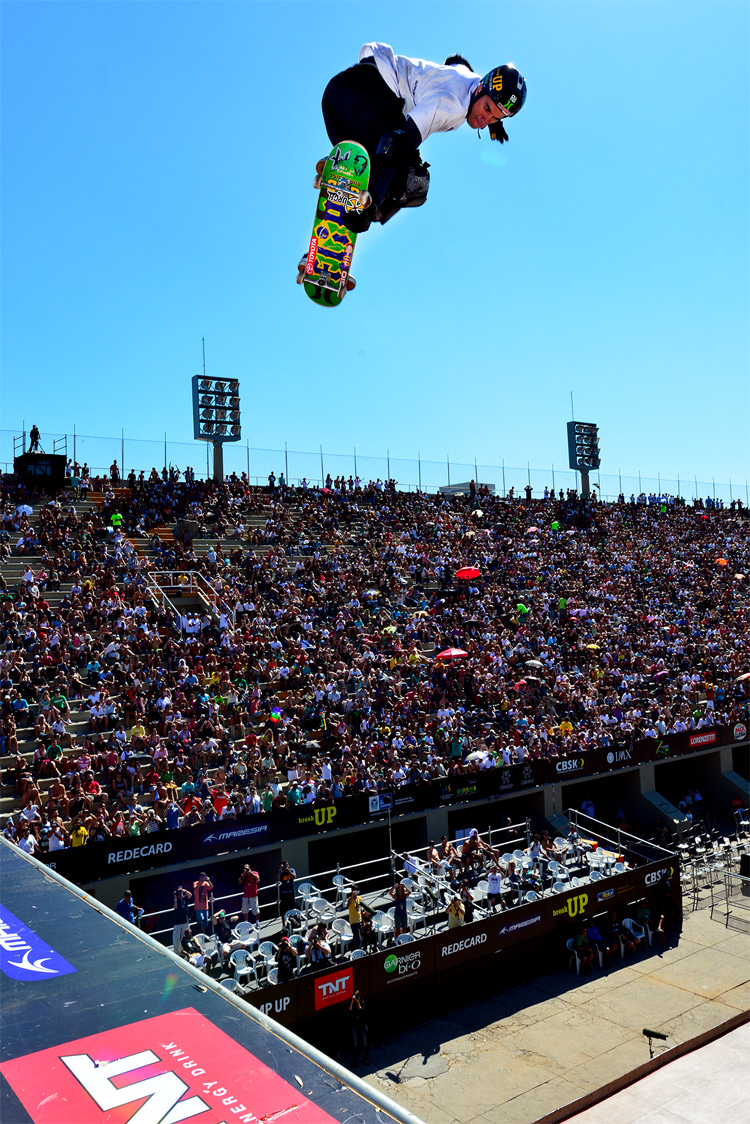
Bob Burnquist comes from Brazil and has an innovative style when it comes to riding vert. He has taken switch stance tricks to new levels.
Included in his runs are switch stance lip slides, blunts, nose blunts, airs, and very technical flip tricks. "I can't remember a time when I didn't skate. I love doing it."
Bob Mohr
Bob Mohr placed fourth in the 1965 Anaheim Nationals. He rode for the Kips Team and led them to victory in a contest that was televised on the Los Angeles television show "Surf's Up."
In the 1970s, Bob rode for Bahne and was known for his impressive gymnastic moves and incredible skill at high jumping. Sadly, Bob took his own life in 1996.
Bobby Boydon
Bobby Boydon was a freestyle competitor who moved into vert riding. He was known for his kickflip variations, including triple kickflips.
Brad "Squeak" Blank
"Squeak" was the first person to ever win a skateboard contest at the 1964 Anaheim Nationals. He rode for Makaha and influenced a generation of skaters.
Brad Bowman
Brad Bowman rode for Sims Skateboards and was heavily featured in many skate magazines during the 1970s and early 1980s.
He was a major threat in pool competitions. "To me, skateboarding means individuality, freedom, and fun."
Brian Beardsley
An extraordinary high jumper, "Flyin'" Brian is best remembered for his leaps over sports cars. Brian rode for Ty Page/Freeformer skateboards.
Brian Howard
One of the smoothest vert skaters ever. In addition to going for big airs, Brian doesn't mind getting technical in the air or on the lip.
One of the first vert skaters to consistently perform technical moves like frontside blunt slides.
Bruce Logan, Brian Logan, Brad Logan, and Robin Logan
The three Logan Brothers were fixtures of the 1960s and 1970s skate scenes. Bruce was known as "King of the Nose Wheelie" and was the dominant freestyler in the 1960s and part of the 1970s. He invented a number of tricks, including the headstand spinner.
From 1964 to 1977, Bruce took first place in over 22 contests. He originally rode for Makaha and went on to ride for the family company - Logan Earth Ski.
Brian and Brad were accomplished riders in freestyle, downhill, and slalom. Their sister Robin was reportedly the first woman ever to do a kickflip.
Together with their mother, the Logans were known as skateboarding's first family.
Bruce Walker
Coming out of Melbourne Beach, Florida, Bruce Walker carved a name for himself on both the East and West coasts. A skater since 1963, Walker's style was based on his surf roots.
In the 1970s, Walker co-owned surf shops and set up Fox Skateboards. This company eventually became Walker Skateboards and was one of the first skater-owned and operated companies.
Cara Beth Burnside
An impressive vert skater who was the first female to get a shoe sponsorship. Cara started skating in the 1980s and became a pro skater in 1990.
Chris Chaput
Chris Chaput excelled in freestyle and was known for numerous handstand variations. He appeared in a number of televised skateboard contests.
Originally sponsored by Logan Earth Ski, he went on to ride for Belair.
Chris Miller
An accomplished vert rider who rode for Santa Cruz, G&S, and Schmitt Stix before starting his own company, Planet Earth Skateboards.
Chris Senn
To put it bluntly, Chris Senn is a wild animal.
As Thrasher stated, "Chris rides a skateboard like a rabid dog: foaming, thirsty, and demented. He dominated the pro street contest circuit during the mid-1990s."
"Being one who enjoys throwing caution to the wind, Chris likes to skate incredibly fast and precise and has a wide assortment of technical and burly tricks."
Chris Yandall
One of the world's most famous slalom riders, Chris Yandall, rode for Gordon & Smith. Included in the sponsorship was his own "honey-colored" Yandall wheel.
Chris is credited with inventing the Samoan Squat. This trick took a regular nose wheelie one step further. To pull it off, the rider had to squat down while maintaining a wheelie.
Christian Hosoi
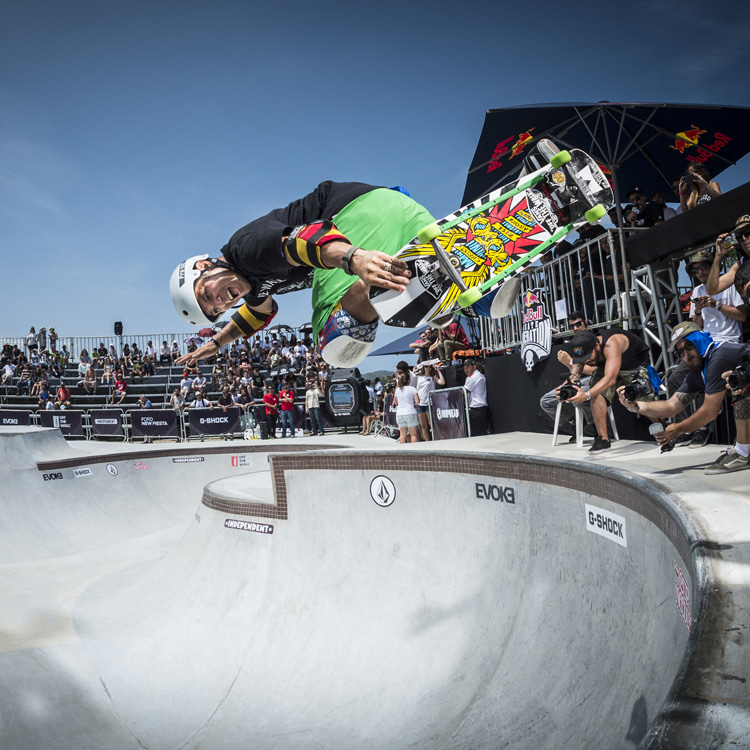
Known for his incredibly huge airs, "Holmes" was one of the biggest vert superstars of the 1980s.
He started life as a pro on the Sims team and eventually promoted his own line of boards, including "The Hammerhead."
Colin McKay
Coming from Vancouver, Colin McKay is a street and vert pioneer. Many tricks that Colin did in the early 1990s in videos like Plan B's "Questionable" video are now standard moves today.
Conrad Miyoshi
Conrad Miyoshi is a slalom champion of the 1970s who perfected a unique parallel ski stance position.
Curt Lindgren
Sponsored by California Freeformer, Curt is known as the originator of the kickflip.
This trick was done by hooking one foot under the board and pressing down with the other. The kickflip was one of skateboarding's first "technical" type tricks.
Danny Bearer
Danny placed first in flatland slalom in the Boys 12 and Under division at the 1964 Anaheim Nationals.
He rode for Hobie Super Surfer Team and, in 1975, wound up riding for Logan Earth Ski.
Quoted in SkateBoarder 1980, "I remember Revere and Bellagio during the early days... 20-foot, wide open banks. Too bad all the kids now are stuck in those pools and can't get out. I've got a piece of ashwood sitting here for a new board. Skating's a good, healthy sport."
Dave and Paul Hackett
These brothers came to the attention of SkateBoarder readers through their astounding use of skateboard suspenders
The suspenders were made of Velcro and enabled Paul and Dave to achieve incredible air without holding the board.
Dave also became a legendary skater of the 1980s and had a successful career with Skull Skates.
Dave Hilton
Dave was the youngest member of the Hobie Super Surfer team. He was the first person to appear on the cover of SkateBoarder magazine (1965).
Dave was also a frequent skater at a pool located in Foxtail Park near Santa Monica. This pool is considered to be one of the first ever ridden by skateboarders.
Dave's brother Steve was also a very talented rider.
Denis Shufeldt
One of the pioneers of skateboarding, Shufeldt was known primarily as a speed racer and downhill master. At one time, he was the team captain for Bahne.
He utilized yoga and stylized fairing techniques to attain speeds of 50+ miles per hour. Even at these speeds, Denis would maintain flawless control.
Desiree Von Essen
Desiree Von Essen was a 1970s freestyle standout. She rode for R.A.C.O.
Don "Waldo" Autry
A legend in the 1970s, "Waldo" ruled vertical terrain, especially pipes.
"At first, skateboarding to me meant that the waves weren't very big, so we'd ride the drainage ditch with our clay-wheel boards. Then we moved to handstands and eventually the Pipeline."
"Twenty years or so later, I'm riding luge. Imagine what it's like to go 65 miles per hour standing up on a skateboard at 41 years of age. Who would have figured."
Doug Saladino
Nicknamed "Pineapple," Doug Saladino was one of freestyle's greatest talents in the mid to late 1970s.
He started skateboarding in 1971 and, at the age of 13, was sponsored by Gordon & Smith Skateboards.
Pineapple also became an accomplished vertical rider, placing in the top five in numerous contests.
Duane Peters
"The Master of Disaster" was a major innovator of many vertical tricks, including the layback roll-out, the sweeper, and the invert revert.
One of Duane Peter's greatest achievements was the "loop of life," a full, 360-degree rotation in a specially designed loop. A totally committed skater since the mid-1970s.
Ed Nadalin
Ed Nadalin is known for his showmanship and would wear a suit and tails during his freestyle routines. He was one of the first to utilize music in freestyle contests during the 1970s.
Eddie Elguera
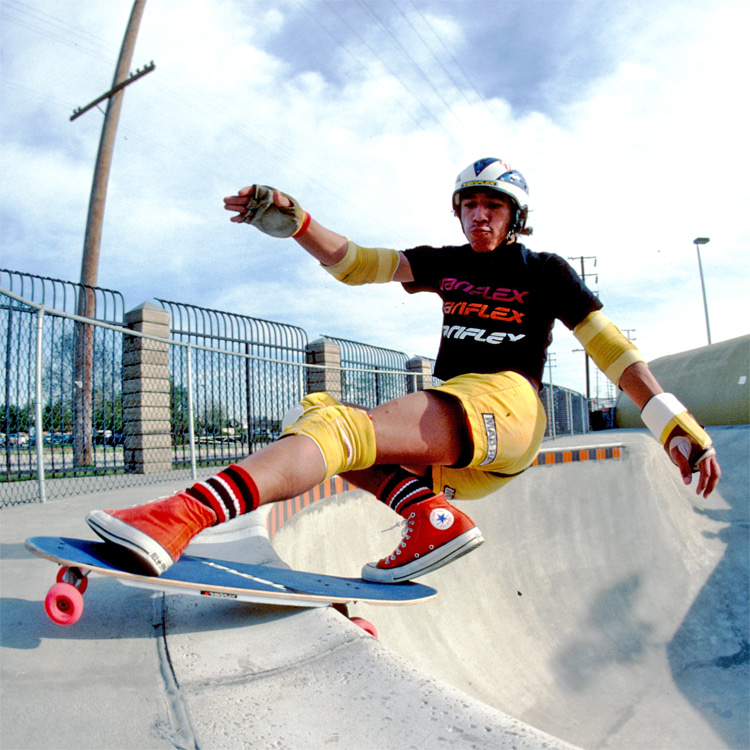
"El Gato" is credited with a number of amazing vertical moves.
Originally sponsored by Variflex, he was the first guy to pull frontside rock and rolls, frontside inverts into fakie (later called the Elguerial), and fakie ollies.
He was an outstanding vert rider in both the 1970s and 1980s.
Ellen Berryman
Known for her gymnastic moves and graceful style, Ellen Berryman was sponsored by Bahne Skateboards.
Ellen O'Neal
One of the top female freestyle skaters in the 1970s, Ellen O'Neal rode for Gordon & Smith. She can be seen in the film "Skateboard."
Known for many two-board moves (called daffy's), she took first and second place in a number of professional freestyle contests.
Elyssa Steamer
One of the most progressive women ever to get on a skateboard. As far as tricks go, Elyssa Steamer has all the bases covered, and she's not afraid to take a painful slam.
Eric Dressen
Appeared in SkateBoarder's "Who's Hot" section at the age of 10. Went on to fame as a top street-style skater.
Originally a rider for Logan Earth Ski, Eric is one of the few riders to span three decades of pro skating.
Eric Koston
An icon in the world of 1990s skating, Eric Koston is an inspiration to many skaters worldwide.
He is known for his abilities and quiet demeanor. Eric makes the impossible look effortless and has single-handedly propelled skateboarding forward in the mid-1990s.
Ernie Martin
Hailing from the East, Ernie Martin had an incredible ability to jump. His crowd-pleaser was jumping over cars, specifically Corvettes. He was able to clear two at a time.
Ernie was also able to high jump five feet and did massive leaps over barrels.
Frank Hirata
Frank Hirata grew up next to Matt Groening (creator of The Simpsons) and was to be the inspiration for Bart's skateboarding stunts. These stunts included riding on his aunt's beat-up car and ollieing over fences, etc.
Gary Kocot
In 1976, Gary was profiled in Circus magazine - probably the first time a skater had been mentioned in a music magazine.
He rode for R.A.C.O. and was an accomplished freestyler and barrel jumper.
George Orton
"The Wildman" was one of the greatest aerial innovators and technicians of the 1970s.
Seventeen years after he became a vert champion, George Orton got back on a board and became a downhill champion. He has hit 61.87 miles per hour on a skateboard.
Gregg Weaver
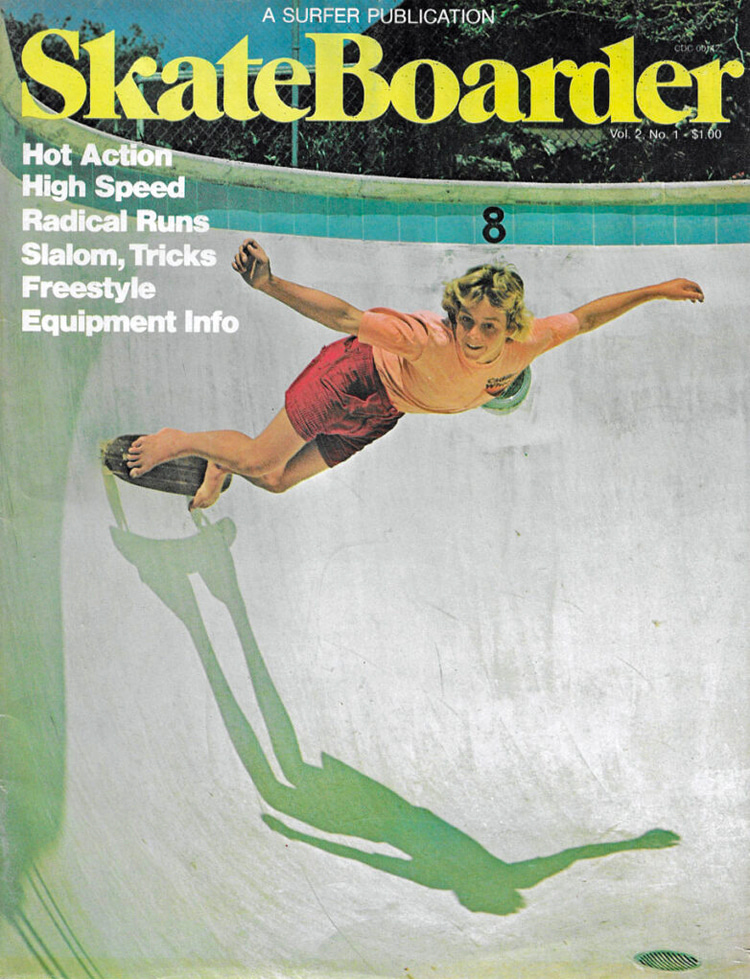
Gregg Weaver wound up on the cover of SkateBoarder magazine's volume 2, number 1 - their first issue since the 1960s.
His smooth, surf-like style influenced a generation of skaters. Gregg was also featured in the Cadillac Wheels print advertising campaigns and became known as the "Cadillac Kid."
Henry Hester
Nicknamed "The Bad H," Henry was one of the kings of slalom skateboarding. Hester Hester had his own deck on Gordon & Smith along with his signature wheel marketed by Road Rider.
As vertical riding became more popular in the late 1970s, Hester started a series of skate competitions that were the foundation for vertical contests.
Jamie Thomas
Hailing from Alabama, Jamie Thomas started out riding for a number of companies, including Toy Machine, and then went on to start Zero.
He is known as a death-defying skater who will try anything.
Jason Jess
Jason Jess rode for Consolidated and was a pioneer of super high airs to fakie, along with numerous revert tricks. He was also known for his intense attitude.
Jason Lee
Jason Lee has had a tremendous influence on the mid to late 1990s generation of pro skaters.
He pioneered such tricks as the backside 180 kickflip, the backside tailslide, and the backside kickflip tailslide.
In addition to having a unique style, Jason is, along with Chris Pastras, a co-founder of Stereo Skateboards.
Jay Adams
Jay Adams' legendary status in the skateboard world stems from his exploits both on and off the board.
A skater and surfer since the age of five, Jay was successful in both freestyle and vertical riding.
His aggressive surf style, coupled with his wild image, garnered him many fans.
An original member of the Zephyr surf and skate team, Jay influenced a generation of skaters.
Jay Smith
Jay Smith was an early Bones Brigade rider. He used a rubberband-like body to maximize flat wall laybacks.
Jeff Kendall
Jeff Kendall was a top rider for Santa Cruz in the 1980s.
"When you are skateboarding professionally, you can't beat it. A lot of my friends went on to college - I don't regret the fact that I didn't get to do that because, as I look back now, I could go back to college any time."
"I remember my life as a pro as being some of the best times in my life. I look back now, and I really appreciate it."
Jeff Phillips
Originally from Texas, Jeff Phillips was an extremely talented ramp rider. His signature move was the Phillips 66, a trick very few skaters could do.
In 1989 Jeff opened his own skatepark, which received rave reviews from all who rode it. Tragically, Jeff took his own life on December 25, 1993.
Jeremy Wray
Jeremy Wray has been taking technical street and rail tricks to new levels ever since he first broke onto the scene in the early 1990s with Blockhead.
He was recruited by Kris Markovitch for Color Skateboards in 1993 - this team later became Prime. His video part from then is still innovative by today's standards.
Jim Gray
Jim Gray was a 1980s pro known for effortless bionic backside foot plants and Lien to backside pro frontside foot plants as well as burly backside airs.
He skated for G&S as a pro and has since gone on to run ABC Skateboards.
Jim McCall
Freestyler Jim McCall came out of Florida and was known for some very impressive gymnastic moves like one-handed handstands.
Jim rode for Fox Skateboards and had one of the first pro models (1976).
Jim O'Mahoney
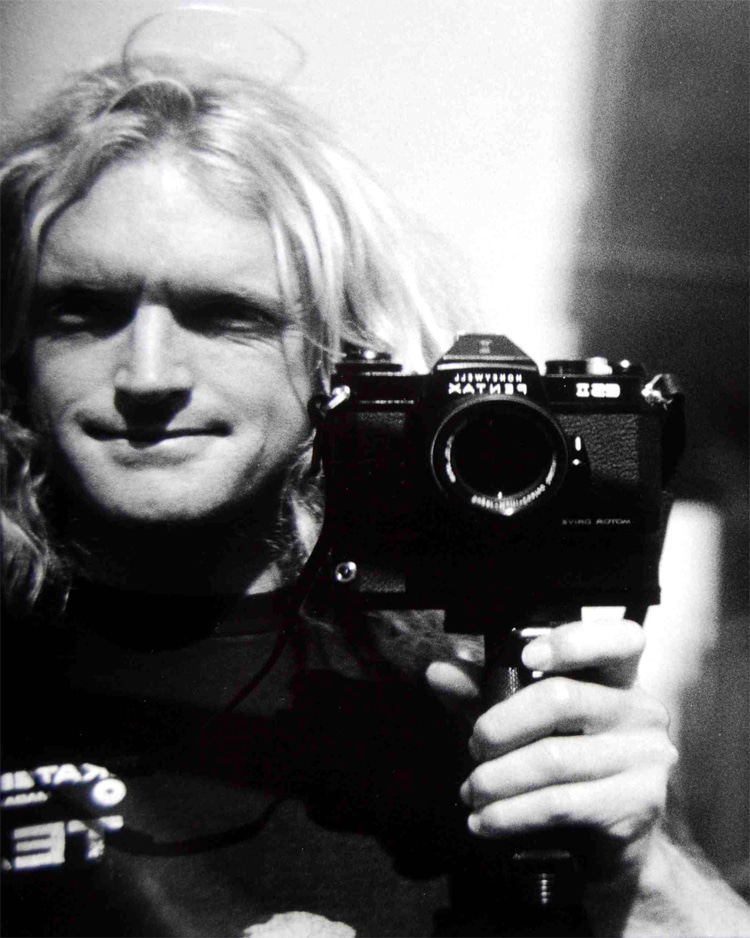
James O'Mahoney was one of the key organizers and players in the mid-1970s skateboard scene. He accomplished a number of interesting things during that time period.
He managed and produced a number of skateboard contests, and his enthusiasm for the sport extended to every continent.
O'Mahoney formed the United States Skateboard Association (USSA), which was a sanctioning body for skateboarding. This led to the formation of the World Skateboard Association.
He also published Skateboard magazine and the "Skateboard Handbook" and helped with the design of skateparks, including The Runway in Carson, California.
He was involved with a number of skateboarding films, including "Go For It."
O'Mahoney submitted the word "skateboard" to the dictionary and was involved in several Guinness World Records skateboard events.
He is still waiting for the US Post office to accept his skateboard stamp.
Joey Cabell
A member of the Hobie Super Surfer team. Credited by Mike Hynson as the developer of slalom skateboarding in the early 1960s.
Joey and Mike used sandals as markers for the course. Soon after, they were found by a cop and told to stop.
John Cardiel
One of the only pro snowboarders that have stayed true to his skating roots. "Cards" is a gnarly skate maniac willing to tackle any terrain.
A card-carrying member of the Northern California Thrasher crew, John Cardiel can bust a backside 540 on vert just as easily as he can slide a slick rail.
John Freis
John Freis won first place overall at the 1965 Anaheim Nationals. He rode for both Makaha and Super Surfer Teams and developed many tricks, including the nose wheelie.
John Hutson
Sponsored by Santa Cruz, John Hutson is best remembered for his speed, both in downhill and slalom.
He won numerous contests, including first place in the downhill event at the Catalina Classic held in 1978.
John was known for his "hut tuck" fairing stance, which helped him achieve speeds of well over 50 miles per hour standing on a skateboard.
Hutson was also a test rider in the development of Independent Trucks.
John Lucero
One of the early pioneers of street skating. John Lucero was thrown out of a skatepark and began pulling moves in the parking lot, to the amazement of skaters.
He has enjoyed a great deal of success with his Black Label skate company.
John Milius
John is known as "The Father of the Kickturn." He was an early skater/surfer pioneer from the Pacific Palisades area.
John went on to write screenplays for Hollywood films, including "Apocalypse Now."
Kareem Campbell
Kareem Campbell is known as a very technical street skater and has been associated with World Industries for many years. He ran Axion, a skateboard shoe company.
Kim Cespedes
Kim Cespedes' skating was influenced heavily by surfing, and her aggressive style paved the way for other females to get into bank riding.
A profile of Kim in SkateBoarder's February 1977 issue remarked that she "is possibly the only female to power slide at speed."
Kim rode for Hobie Skateboards.
Kris Markovich
When everyone else was doing triple kickflips two inches off the ground, Kris Markovich was throwing himself off double sets and flipping big gaps.
Kris looked to be powered by pure adrenaline at a time when skating became slow and technical. Definitely a standout at any session and a true madman.
A fine example of this crazed skating can be found in the early 101 videos where Kris is doing flip tricks at super fast speed.
Lance Mountain
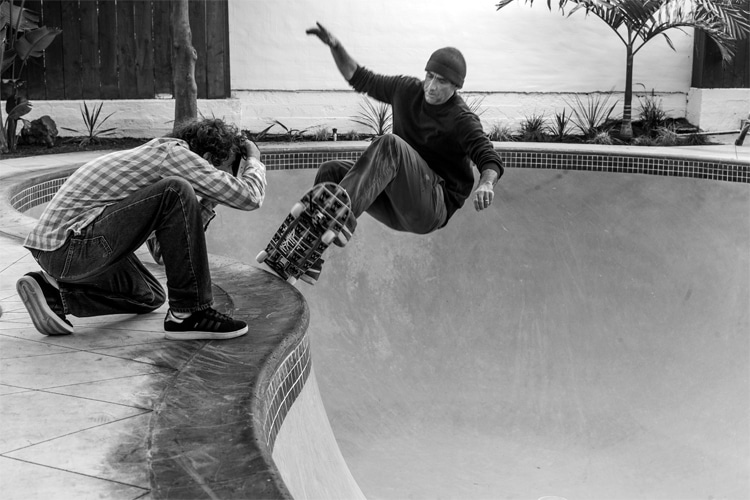
Originally a rider for Variflex in the late 1970s, Lance Mountain became one of the key members of the 1980s Bones Brigade.
Lance could be seen hosting "411 Video Magazine" every month. In 1992, Lance started his own skateboard company called The Firm.
Larry Bertlemann
Another surfing superstar who crossed over into skateboarding. Larry Bertlemann's carefree, flowing style influenced many skaters.
The "Bertlemann," or "Bert" for short, was his signature move and was successfully transitioned to vertical environments.
Laura Thornhill
A graceful freestyler who rode for Logan Earth Ski, Laura Thornhill was known for her spacewalk 360s.
"Skateboarding was my way of life for many years. I have a collection of longboards in my garage along with a Laura Thornhill model, and now I just ride for fun."
Lester Kasai
Lester Kasai was a big air innovator from the 1980s. Super stylish, super rad vert skater. The Sims "Lester" board was immensely popular.
Lonnie Toft
Lonnie Toft rode for Sims skateboards and was instrumental in redesigning skateboards.
He is best known for his "Outrageous" Eight Wheeler and for being one of the first skaters to embrace and promote snowboarding.
The eight-wheeled skateboard was quite difficult to ride, but Lonnie was able to take it to vertical terrain with no problem.
Lonnie also originated the G-turn with Gordy Lienemann.
Mark Gonzales
Mark Gonzales is a street-style legend. The first rider to do handrails and the inventor of numerous ollie-based tricks.
Originally a rider for Vision, street-skaters the world over owe a huge amount to Gonz's talents.
Mathias Ringstrom
"Skateboarding used to mean everything to me when I was younger. It was what I dreamed, thought, and lived for."
"Now it's still almost the same, except it's also my living which makes it a bit different."
Matt Hensley
In the late 1980s, Matt Hensley came up through the ranks as a next-generation street skater. By the time the 1990s rolled around, he was at the top of the sport
Best known for his progression of stylish modern street skating, Matt retired from professional skateboarding in 1992, only to make a comeback a few years later.
Micke Alba
Younger brother to Steve, but no less accomplished. Malba won numerous contests and ripped vertical terrain.
Mike Crum
Mike Crum is a super technical skater from Texas who stuck with vertical riding all through the era when vert was dead (early to mid-1990s).
When vert started to come back, he found a home with the World Industries posse. On the progression front, Mike has taken frontside nollies to new heights on vert.
"Skateboarding to me means skating with friends, fun, and scars!"
Mike Frazier
A 1990's skater with intense determination. Mike Frazier pushes everything to the max.
An exciting skater to watch, Mike appears to always be on the verge of losing control and yet doesn't let many tricks get away from him.
Mike Hynson
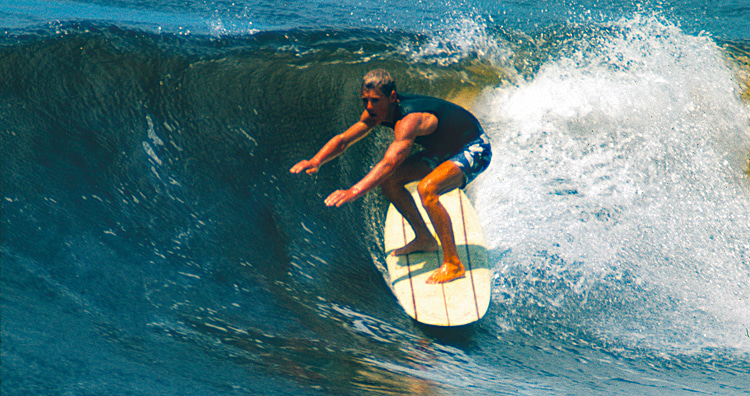
A surfer who appeared in the legendary film "The Endless Summer," Mike got heavily involved with skateboarding.
He joined the Hobie Super Surfer team for a tour out East.
Mike Santarossa
Mike Santarossa first came to light as a standout at the Powell Skateboard Park in Santa Barbara in the early 1990s. He is a versatile skater who is equally talented in the street and on transitions.
"Skateboarding for me means just being able to do what comes naturally. Not that I'm some natural skateboard wizard or anything, but growing up around skateboarding for me was a natural thing."
"When I realized what could be accomplished between myself and the board, I was hooked. I found my first love."
Mike Vallely
One of the best street skaters from the late 1980s, Mike Vallely was originally sponsored by Powell Peralta. He was known for his innovative style, and his riding has influenced a generation of skaters.
"When I was 14 years old, I started skateboarding, and my life was changed for the better that day. It was changed because, at that time, I found a sense of purpose, a reason to hold my chin up."
"I got an identity and something productive. It was a creative, physical activity, and I used my entire being to do it. I found my thing, my niche, and up until that time, I had been searching."
"I think it was the most important time to find something like that because I was able to bypass all the bull that you usually have to go through as a teenager."
"It made my life better, and it's now many years later, and it still remains what it was that first day. I am very protective of my initial dealings with skateboarding."
It's hard, but I try to ensure that other kids who are starting out get that same experience. It's a good thing for young people to do that brings many rewards."
Mike Weed
One of the most accomplished vertical and freestyle skaters of the seventies, Mike Weed rode for Hobie and toured around the world.
Monty Nolder
A strong vertical skater from the 1980s who rode for Gordon & Smith. Monty Nolder was one of the first (if not the only) deaf skate star.
Natas Kaupas
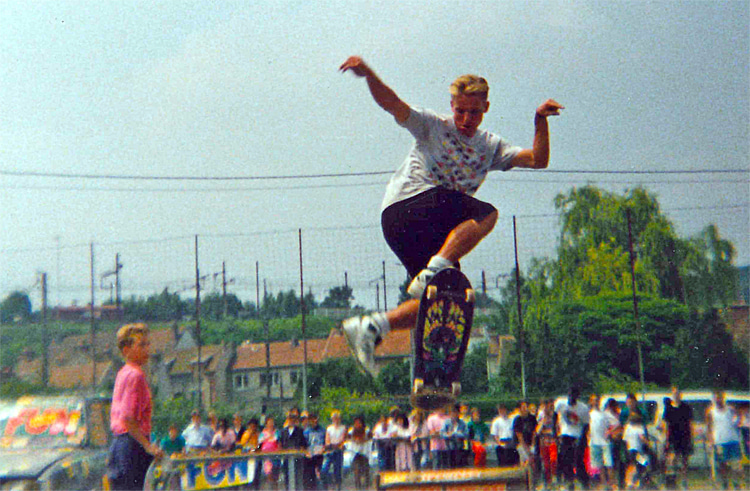
One of the major street-style skaters of the 1980s, Natas Kaupas' influence can still be felt today.
His reworking of the ollie pushed the sport into new areas. Natas rode for Santa Monica Airlines and then Santa Cruz.
He eventually wound up with Steve Rocco and created 101. The first skater to have a signature shoe by Etnies.
Neil Blender
Known by many as a visionary. Neil Blender invented the "lien" (Neil spelled backward) air, along with pioneering all sorts of difficult lip tricks in the 1980s
In an article in Thrasher, he foretold the trend of all boards being exactly the same size/shape and that the graphics would be most important, second only to skate "fashion" (clothing, etc.).
Omar Hassan
A standout on any terrain, Omar Hassan began riding in 1990. "Skateboarding to me just means fun. Hanging out with my friends that skate - that's it."
Pat McGee
Hailing from San Diego, Pat McGee was known as a trick rider of the highest order. She was featured on Life magazine's cover doing a headstand in 1965.
Paul Hoffman
A member of the Z-Flex team, Paul Hoffman was an accomplished freestyler. His signature trick was the one-footed nose 360.
Per Welinder
Per Welinder was a Swedish freestyler/streetstyler who incorporated both strength and technical moves into his routines.
He rode for Powell Peralta and joined forces with Tony Hawk to create Birdhouse Projects.
Phil Edwards
One of the world's most famous surfers, Phil Edwards, also got heavily into skateboards in the 1960s.
He had an enormous impact on the skateboard world and aided the successful transition of the image of skateboarding from that of a toy to a sport.
Pierre Andre
One of the most talented freestylers to emerge from Europe in the 1980s. Pierre Andre competed at an international level and finally settled in California.
He rode for Sims and now heads up the skate shoe company Etnies.
Primo Desiderio and Diane Veerman
1980s freestylers with incredible sharp footwork. Primo Desiderio and Diane Veerman took their synchronized freestyle skate act on the road for God.
While toe-tapping and spinning their decks to disco, they would not only get cash but recite little biblical lessons at the same time.
The couple eventually married.
Ray Barbee
Ray Barbee's flatland tricks impressed a lot of people in the 1988 Powell Peralta video "Public Domain."
Over the years, he has developed numerous ollie variations, including the ollie blunt. Ray is one of the true pioneers of technical skateboarding.
René, Ritchie and David Carrasco
Three brothers who performed as part of the Pepsi Skateboard Team. Ritchie is one of the best 360 spinners in the world and hit over 130 revolutions in the 1970s.
As a result of this achievement, Hobie introduced "Spinners" - wheels made especially for doing 360s.
Rick Blackhart
One of the greatest skaters to emerge from Northern California, Dr. Rick was instrumental in the development of Independent Trucks.
Blackhart also wrote a skateboarding advice column for Thrasher called "Ask the Doctor."
Rick Howard
Rick Howard, one of the founders of Girl Skateboards, has an extremely smooth style and is known for his innovative tricks.
Before most people had perfected backside kickflips and tailslides, Rick had them wired switch stance using his opposite leg.
Rob Dyrdek
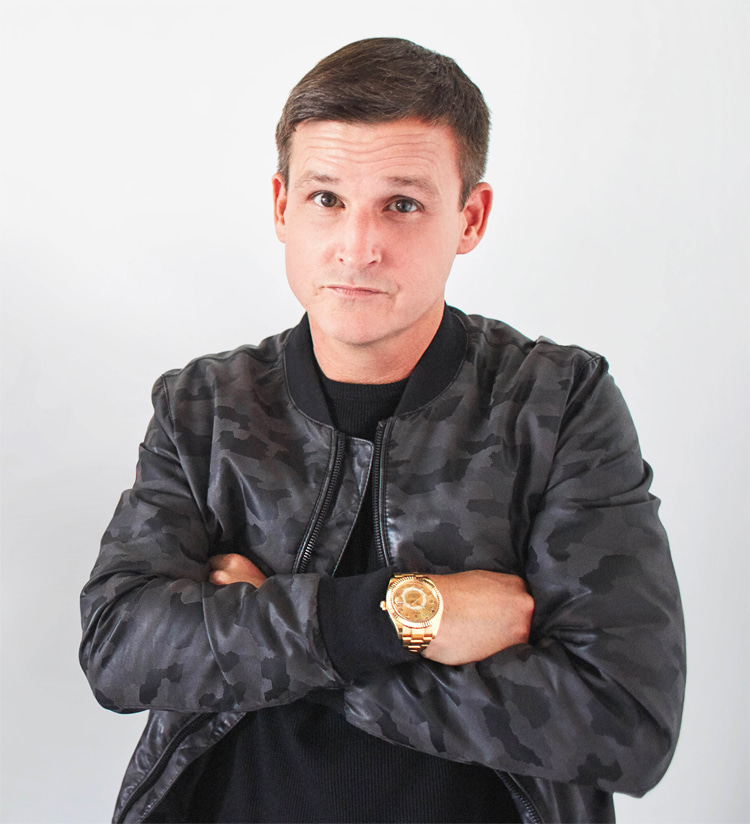
Streetskater from Ohio. Has spent his entire career on the Alien Workshop team.
Rob Dyrdek has been on top of solid technical skateboarding street skating since the early 1990s. Always the guy to watch if he's at a contest.
Rob Roskopp
Originally from the East (he has lived in Michigan and Ohio), Rob Roskopp moved out to California in the early 1980s.
Within three months of his arrival, he was sponsored by Madrid and, after a year, wound up riding for Santa Cruz. Rob was a very strong rider in both vert and street.
Robert Valdez
Robert Valdez was the first skater to pull off an invert on vertical in a major competition at Big O Skatepark with his arm set in a cast. Sponsored by Powerflex.
Rodney Jesse
Sponsored by Brewer Skateboards, Rodney Jesse took an aggressive approach to his skating.
Rodney Mullen
Rodney Mullen is often considered the most influential street skater of all time despite having started as a freestyler. He is also the Yoda of skateboarding.
Mullen invented more tricks than any other rider and created and ran several skateboard companies.
Ron Knigge
Sponsored by New Deal in the early to mid-1990s, Ron Knigge influenced the growth and popularity of extremely technical skating.
Rudy Johnson
A real street pioneer who had a strong and innovative video part in Blind's Video Days. Rudy was a founding member of the Girl team.
Rune Glifberg
Rune Glifberg is from Denmark and is known for his technical ability and lip tricks. He has become one of the most accomplished vert riders of all time. He rides for Flip Skateboards.
"Skateboarding is an individual sport. You can pretty much do it anywhere. It's a thing you can do on your own, and you don't need anyone to tell you what to do. It's all about fun, really pushing your own limits, and riding everywhere."
Salman Agah
"Sally" pretty much single-handedly brought switch stance skating to the level it is at today.
Because of Salman Agah, today's top skaters are generally expected to have an extensive switch repertoire.
Known for his close association with the Christian faith, Salman continues to be an inspiration in the world of skating.
Scott Foss
One of the first Bones Brigade riders. Best known for burly backside air.
Sergie Ventura
Sergie Ventura is known for his vertical riding. He has a style similar to Christian Hosoi's.
Shogo Kubo
One of the original Z-Boys from Dogtown, Shogo Kubo, was known for an incredibly smooth style.
He was an immensely popular skater and went on to become the resident pro at the Cherry Hill Skatepark in New Jersey.
Simon Woodstock
A 1990s rider known for being somewhat eccentric.
Simon Woodstock rides some rather unusual boards, including "Double Trouble" (with trucks on the top and bottom of a board) and a skimboard with trucks and wheels.
He dresses up as a clown occasionally.
Skip Frye
Long-time surf legend Skip Frye was part of the first wave of skateboarding in the early 1960s. Skip rode for many years on the Gordon & Smith team and promoted their classic Fibreflex boards.
Skitch Hitchcock
Known as an innovator and master craftsman, Skitch Hitchcock designed and made his own decks. He was also an excellent freestyle skater and blew people away with his gorilla grip.
This trick consisted of Skitch skating barefoot, grabbing both ends of the boards with his toes, and leaping off ramps.
He could spin a complete 360 mid-air with the board gripped by his toes. A health food nut, Skitch once said that drinking carrot juice made him jump higher.
Stacy Peralta
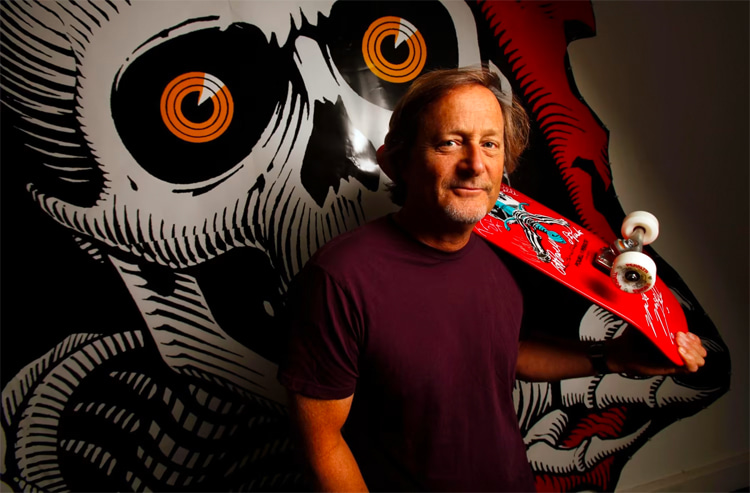
An original Z-Boy who went on to more fame with Gordon & Smith - his Warptail model was a best seller. A master of both vertical and freestyle skating.
When Stacy Peralta joined up with George Powell to create Powell Peralta, it became one of the biggest skate companies of all time.
Steve Alba
A huge force in both pool and pipe, "Le Machine" dominated the Upland Skatepark along with Mt Baldy.
Known for his awesome feats in the desert pipes of Arizona (some over 20 feet in diameter), Steve "Salba" Alba would kickturn over the vertical part.
Steve Caballero
Steve "Cab" Caballero is one of skateboarding's legends.
He was first sponsored by Campbell Skatepark in 1979, the year after he picked up the sport, and later that year, he was picked up by Powell Peralta.
He has been with Powell since that time. Steve invented the "Caballerial" and was known for huge backside airs.
When asked, "What advice do you have about longevity?" Cab told Thrasher magazine: "Just having a nice, positive attitude towards everything that has to do with skateboarding."
"Skateboarding is my whole life - ever since I was 13 years old. Basically, I've made a career out of it, and I enjoy it as much as I did when I first started."
Steve Cathey
Steve Cathey's style was surf-inspired and extremely smooth. He rode for Gordon & Smith Fibreflex and was the innovator of many freestyle tricks.
Steve was also pictured on SkateBoarder's subscription envelope inside the magazine.
More recently, Steve's image can be found on logos from longboard manufacturer Sector 9. "For me, skateboarding came about as a mode of transportation; it was a reflection of surfing."
"When the surf wasn't good, we skateboarded. For me, being a pro was the best experience I could have had. It was an opportunity that any kid would have loved."
Steve Olson
"Bulky" dominated vertical skating in the late 1970s.
In 1978, John Krisik, director of competition for Santa Cruz Skateboards, summed up Steve Olson's talents in the magazine Wide World of Skateboarding: "I believe Steve is the number one bowl rider in the world today."
"He has so many strengths: he's physically sound, well-coordinated, and has a great sense of spontaneity. He can walk into an unfamiliar bowl and begin to rip it right away."
Steve rode for Santa Cruz and was on the original test team for Independent Trucks.
Tim Brauch
Tim Brauch was a top 1990s skater: "Skateboarding is a way to express myself. A way to leave all my troubles behind. It's guaranteed that you'll have fun when you do it."
Tim Scroggs
A Florida skater who developed an arsenal of impressive freestyle tricks in the late 1970s.
Tim Scroggs rode for Powell Peralta and was famous for his toques, which he would wear completely over his face.
Tim was one of the first skaters ever to do an acid drop, leaping up with the board and then landing on it.
Tom Boyle
Tom Boyle is one of the 1990s strongest and most consistent vertical riders, hence the nickname "The Rock."
"Skateboarding means creativity. At this point in my life, it is my whole life. Skateboarding means freedom - the never-ending freedom to do new things. It's just an awesome device."
Tom Groholski
Originally from New Jersey, Tom Groholski skated for Vision in the 1980s and was an accomplished vert rider.
Tom Inouye
"Wally" was one of the premier vert riders of the 1970s. He was one of the first to get an air out of a vertical ramp. Tom Inouye was the designer and builder of the Del Mar Skatepark.
He is also known primarily for his company, Inoyoue's Pool Cleaning Service. He possessed one of the smoothest riding styles of any skater.
Tom Sims
As the father of the longboard, Tom Sims combined his love for surfing, skiing, and skateboarding and had a tremendous impact on the sport.
He was also an early promoter and developer of snowboarding. Starting in the early 1970s, Tom made enormous skateboards for himself and his friends using water skis.
Eventually, his company, Sims Skateboards, marketed wheels along with boards and became a giant in the industry.
Tommy Guerrero
An awesome street-style skater who took the ollie to new heights at the start of skateboarding's third comeback in the 1980s.
Tommy Guerrero's ollies in the streets of San Francisco on the Powell Peralta videos set the foundation for street skating to become enormously popular during the 1980s.
Tony Alva
Tony Alva was born with the talent to ride a skateboard. He aspired to become a champion skater, and he managed to realize his dreams.
The godfather of modern skateboarding had a unique style that blended surfing and skating. Fame and partying almost destroyed his career, but Alva was able to change his life for the better.
Tony Hawk
Tony Hawk is the most successful competitive skateboarder of all time and also the most triumphant skater-entrepreneur in the sport's history.
He inspired several generations of riders and kept his flame alive and healthy way into his 50s.
"Birdman" brought skateboarding into the mainstream and won millions with his "Tony Hawk's Pro Skater" videogame series.
Hawk won world titles and X Games trophies and is one of the original members of the Bones Brigade.
Tony Jetton
Tony Jetton rode for Pepsi, G&S, and Tracker Trucks. He was also one of the stars of Skateboard Mania, a spectacular skateboard show that was produced in the 1970s.
Tony Magnusson
Tony Magnusson was an impressive Swedish skater who competed strongly against all the California pros. He rode for Uncle Wiggly, which then led to the development of H Street (with Mike Ternasky).
After H Street, Tony started Evol. Tony was a featured competitor in the 1997 X Games.
Torger Johnson
One of skateboarding's greatest legends, Torger invented many freestyle tricks, including the spacewalk, a maneuver in which a rider balances on the back wheels and moves the board sideways in the air.
He had a solid surfing background and won many contests. Tragically, Torger died in a car accident in 1988.
Ty Page
"Mr. Incredible" was known for his fast footwork and astounding pirouettes. Ty Page would do high jumps or carve up steep banks and turn 360 degrees with amazing height.
He rode for California Free Former and had one of the first signature models. Page is best known for the "Ty Slide."
Vicki Vickers
One of the top female vertical riders of the 1970s. Vicky Vickers gained a huge following among both female and male riders.
Willy Santos
He may be small in stature, but Willy Santos' skating ability speaks volumes.
His Hawk-like ability to throw technical street and obstacle course tricks back to back has earned him many contest victories and top placing. Willy was sponsored by Birdhouse.
Woody Woodward
Although known for his skating ability, Woody Woodward is best remembered for his profile in Surf Guide.
Writer Bill Cleary featured Woody as a cigar-smoking "titan of the skateboard industry." Woody was nine years old at the time.
Words by Michael Brooke | Skateboarder and Author of "The Concrete Wave: The History of Skateboarding"
